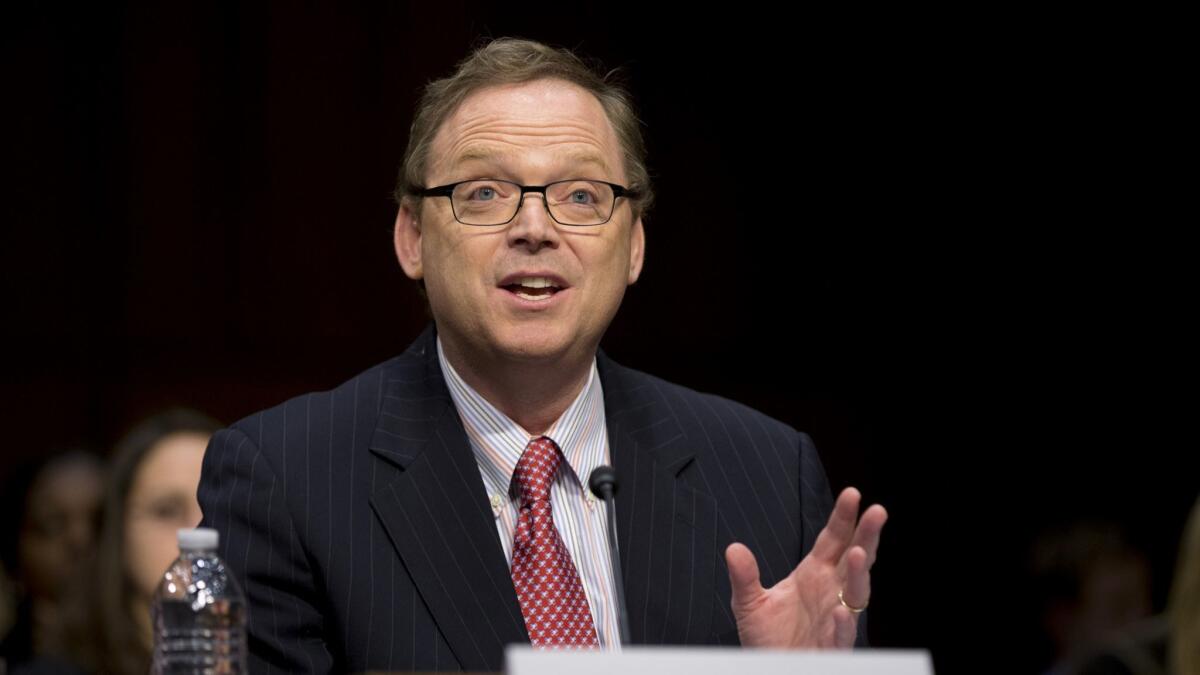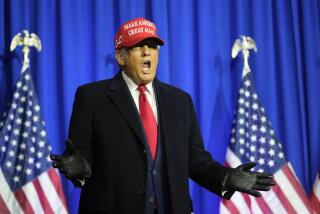Column: Not even Trump is expecting 3% growth anymore

Donald Trump built his presidential campaign in part around a promise to jump up U.S. economic growth to 3.5% a year or even 4%, a big improvement over the 2% average of the previous decade.
Since taking office, however, Trump has struggled to come close even to 3%. This week, his Council of Economic Advisors essentially has admitted that long-term growth meeting Trump’s promise is not going to happen. The acknowledgment comes in the 2019 Economic Report of the President, released Tuesday.
Under current conditions, the report says, inflation-adjusted gross domestic product, which the report claims was 3.1% in 2018, will be less than 3% from 2020 through 2029, falling almost as low as 2% in 2026.
Even these figures result from a bit of massaging. Actual GDP growth in 2018 was 2.9%, not 3.1%. The administration uses a fourth quarter-to-fourth quarter statistic, not the actual growth in 2018 compared with 2017.
In May 2017, we described Trump’s quest for economic growth better than 3% as a “pipe dream.” It looks as though the chief White House economists now agree.
Moreover, Trump’s projection that GDP will grow by more than 3% this year is scoffed at by economists. The consensus projection for first-quarter GDP, as tracked by the Federal Reserve Bank of Atlanta, is 1.5%. The Atlanta Fed’s own GDP Now projection, based on monthly figures for the economic indicators composing the official GDP statistic, is for 0.4% annualized growth for the current quarter. The New York Fed’s Nowcast projection calls for 1.37%.
The Federal Reserve’s board of governors isn’t especially sanguine about the future rate of growth, either. In a monthly economic assessment issued Wednesday, the Fed observed that “growth of economic activity has slowed from its solid rate in the fourth quarter” and that “recent indicators point to slower growth of household spending and business fixed investment in the first quarter.”
The White House does say that 3% economic growth is achievable “assuming full implementation” of Trump’s economic policies. This is what’s known either as a “big If” or a “magic asterisk,” but it’s proper to look closely at what economic policies the report is talking about.
In a nutshell, it means further tax cuts building on the cuts Trump signed into law in December 2017, “an infrastructure program… which we assume will commence in 2019 with observable effects on output beginning in 2020,” and more deregulation.
None of these is a political slam-dunk, especially with a Democratic House likely to devote greater scrutiny to Trump policies than they received from a Republican majority.
But the issues aren’t simply political. For all the talk of an infrastructure plan, Trump hasn’t actually proposed one of any substance. His only formal proposal, issued in February 2018, had a $1.5-trillion headline number but provided for only $100 billion in federal funds over 10 years for major federal-state projects — and those funds were then and now mostly mythical. To design and enact a real plan before the end of this year is yet another pipe dream.
As for the deregulatory initiatives, the economic report underscores another issue of Trumponomics: Whose GDP are we talking about?
Let’s take a look at a few regulations highlighted in the report.
They include eviscerating the National Labor Relations Board’s Obama-era effort to crack down on misclassifications of employees as “independent contractors,” which deprives those workers of protections against workplace abuses. The Trump NLRB has stopped that crackdown dead.
Trump is also proposing to roll back Obama rules expanding the number of employees eligible for overtime pay; Trump’s proposal would reduce the number of additional eligible workers to 1.1 million from Obama’s 4 million.
Trump also is trying to eviscerate environmental regulations that promote clean air and water free from contamination by industrial pollution. He’s trying to roll back regulations on auto emissions and fuel efficiency designed to reduce greenhouse gases and smoky exhaust. And he has emasculated the Consumer Financial Protection Bureau’s ability to regulate consumer lenders.
Obviously, this variety of deregulation harms workers, residents of regions beleaguered by bad air and poisoned water, and consumers abused by unscrupulous banks, mortgage companies and payday lenders. Would they consider losing those safeguards in return for a fractional increase in overall GDP to be an economic advance? Doubtful.
Lumped in with the deregulation initiatives are the efforts by Trump and his Republican enablers to undermine and effectively repeal the Affordable Care Act. The economic report asserts that eliminating the individual mandate’s penalty for failing to carry insurance, a change that went into effect this year, will create a “total net benefit” of $204 billion over 10 years.
What the report really means is that expenditures by the federal government will fall by $204 billion. That’s because eliminating the penalty will prompt millions of Americans to drop their health coverage, relieving the government of the need to pay subsidies for their health insurance.
This is an odd way to calculate the net benefits of a policy that will lead more people to be uninsured or underinsured, especially since lack of health coverage functions as a hidden tax on workers, employers and hospitals.
Finally, the report treats Trump’s tariff increases and the trade wars he has launched as economic benefits. That’s at odds with economic analyses of the first year of the tariffs, which find that they’ve depressed GDP.
In sum, the economic report makes unsupportable claims for the few notable policies that Trump has implemented thus far and calls for more of the same, despite evidence that they haven’t worked as expected in the first instance. Pipe dreams are what this administration is made of.
Keep up to date with Michael Hiltzik. Follow @hiltzikm on Twitter, see his Facebook page, or email michael.hiltzik@latimes.com.
Return to Michael Hiltzik’s blog.







